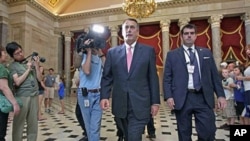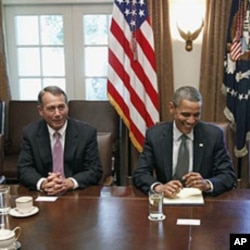The White House and congressional leaders of both major political parties are pressing rank-and-file legislators to support a last-gasp bipartisan deal to trim U.S. government spending and raise the federal borrowing limit. Votes are expected in both houses of Congress ahead of Tuesday’s deadline to raise the debt ceiling or risk a possible default on U.S. obligations.
Financial “Armageddon”
One day before the United States faces what President Barack Obama has called financial “Armageddon,” congressional passage of the compromise debt bill is far from assured. In a final effort to round up wavering votes, Obama dispatched Vice President Joseph Biden to Capitol Hill to address Democratic lawmakers from both chambers.
Biden was asked if he believes the bill cutting trillions of dollars in federal spending and extending the borrowing limit through next year will pass.
“Oh, that is up to the House [of Representatives],” he said.
It is in the Republican-controlled House of Representatives where the vote count is expected to be particularly close, given fierce opposition already expressed by its most conservative Republican - and progressive Democratic - members.
Mikulski: far from enthusiastic
|
U.S. Debt Deal Facts
|
But even in the Senate, the vice president clearly had convincing to do. Democratic Senator Barbara Mikulski of Maryland says she does not want to risk a downgrade of the U.S. credit rating, but is far from enthusiastic about proposed cuts in federal spending that could harm the poor and vulnerable.
“I also need to know more about just where we are heading in terms of what these [budget] cuts mean,” she said.
Tea Party
On the Republican side, several members of the fiscally conservative Tea Party faction say the bill does not go far enough to rein in what they see as an out-of-control Washington spending binge. Senator Marco Rubio of Florida says he will vote ‘no’.
“I ran [for office] because I wanted this country to be put on a sustainable spending path. This bill does not do that," said Rubio. "There will come a time when we [the U.S. government] will not be able to borrow money, not because of the debt limit, but because our lenders will not lend it to us anymore. This plan does nothing to prevent that day from coming.”
Compromise
In announcing the agreement late Sunday, President Obama said the deal is far from perfect, but better than doing nothing and watching the nation fall into financial ruin. Senate Majority Leader Harry Reid echoed that message Monday.
“No one got what they wanted. Everyone had to give something up. It was a compromise," said Reid. "It is not always easy to get two sides to reach consensus. But that is what we did. We did it on a bipartisan basis.”
Republican congressional leaders who helped negotiate the deal with the White House and their Democratic counterparts say the bill achieves less in deficit reduction than they had hoped. But they note the bill contains no tax increases, a key Republican demand from the beginning of contentious negotiations that lasted several months.
Two rounds of spending cuts
If enacted, the bill provides for two rounds of spending cuts. The first round would produce $900 billion in budget savings over 10 years. The bill mandates the creation of a bipartisan congressional committee to identify more than a trillion in additional deficit reduction that would be subject to an up-or-down vote at the end of this year. The bill forces automatic cuts if the committee is unable to reach an agreement.
In return for deficit reduction, the bill would raise the U.S. debt ceiling by more than $2 trillion, enough to assure the federal government’s solvency through next year’s national elections. The U.S. national debt stands at $14.3 trillion.












